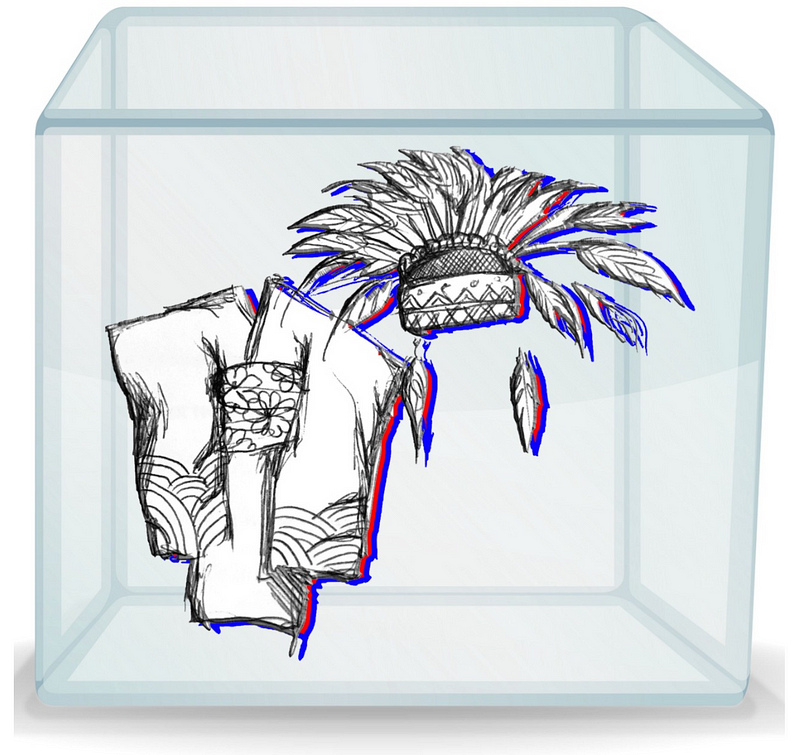
Illustration by Heidi Wong ’20 and Charles Dunst ’18
Editor’s note: the views expressed on the Opinion pages are those of our writers and are not necessarily representative of the Editorial Board.
Halloween has always been a popular time of the year for people of all ages. Bizarre costume ideas have always managed to either amaze or disgust the general public and this year is no exception. Recently, a new wave of criticism regarding the cultural sensitivity of Halloween costumes has flooded the public forum. In the current political climate, a (seemingly) innocent festival about candy, neighborly visits, and spooky fun has sparked controversy. Several institutions have advised college students to avoid inappropriate and possibly offensive costumes, and while I do not think a warning is going to prevent someone from dressing up like a Native American chief or a bloated sumo wrestler, I do believe that we should consider why it is that people feel the need to do this in the first place.
One puzzling thing about Halloween is why a holiday supposedly about “monsters” came to accept virtually any costume as relevant. Since when did it became a trendy thing to dress up as a nurse, or a fireman, or any other profession? This shift in expectation has allowed manufacturers to produce previously unthinkable ideas without concerning themselves with consequences of doing so. These days, it does not matter what a person wears during Halloween as long as it is creative or flashy enough to grab attention. Our permissive attitude makes it difficult for many people to understand why the issue with inappropriate costumes even exist. This attitude, however, hurts those for whom aspects of their identity is intrinsically linked with these outfits.
A great example would be wearing a person’s national costume or traditional clothing to walk amongst vampires, werewolves, and mummies. It is disturbingly painful to see something that one regards as an essential part of one’s identity being trivialized or reduced to the level of monsters and boogeyman. Seeing something like this makes groups feel as if their identity is insignificant to the society, that their existence is on par with monsters lurking in a child’s nightmare. It is almost a subtle form of mockery. Though not explicitly demeaning, wearing these costume treats important aspects of someone’s identity with an inappropriate degree of levity.
To add insult to injury, the discomfort inflicted by cultural insensitivity compounds itself when a costume is associated with ethnic groups becoming cultural appropriation. The worst offenders in this category include any costume that resembles Hispanic, African American, Native American, or traditional Asian culture.
These costumes invariably require some degree of makeup that mimics stereotypical physical features of ethnic people.
To understand why anyone would be compelled to treat different ethnic groups this way, it is necessary to return to the idea of trivializing the grotesque and the “exotic.” Practices like these essentially minimize cultural practices and reinforce negative stereotypes about those people.
I am not, of course, blaming the individuals alone for purchasing offensive costumes.
Understandably, the majority of people do not intentionally offend others, and when such offenses do occur, it is mainly attributable to ignorance or apathy. The issue with Halloween costumes can be traced to the greater problem of commercializing festivals in our consumerist society, in which the manufacturers of costumes prize profits above all else.
During the Halloween season, millions of Americans spend their money on bags full of candy, Halloween-themed home decors, and, most importantly, the vast array of costumes available for purchase online and in stores. The corporations that design and sell costumes have little incentive to consider cultural sensitivity if a particular costume is popular. The public wants a costume that has absolutely nothing to do with Halloween? No problem! If the public wants an exotic look — here you go — a grossly distorted image of a culturally appropriated Native American Indian vacuum-sealed in a plastic bag.
Under these circumstances, offensive costumes are inevitable. I think it is safe to say that the days when a child can dress up as a ghost by wearing a blanket with two eye-holes before she goes trick-or-treating with friends is gone. I am not trying to dampen the Halloween spirit by telling people not to wear a costume, but I do want to say that when you put on a costume next time, think about what that outfit entails and how you would feel if your identity was the one being paraded around in the streets.
